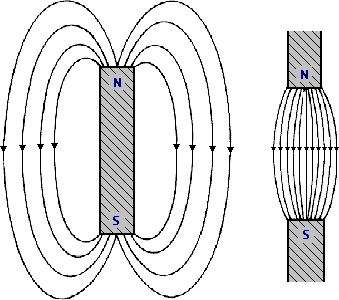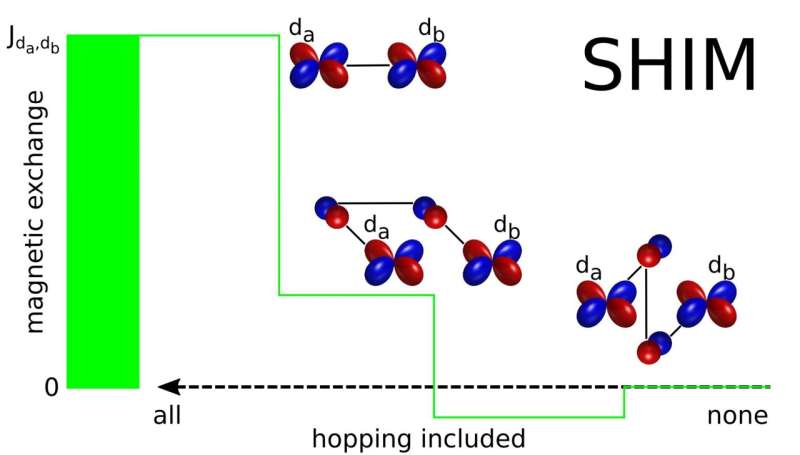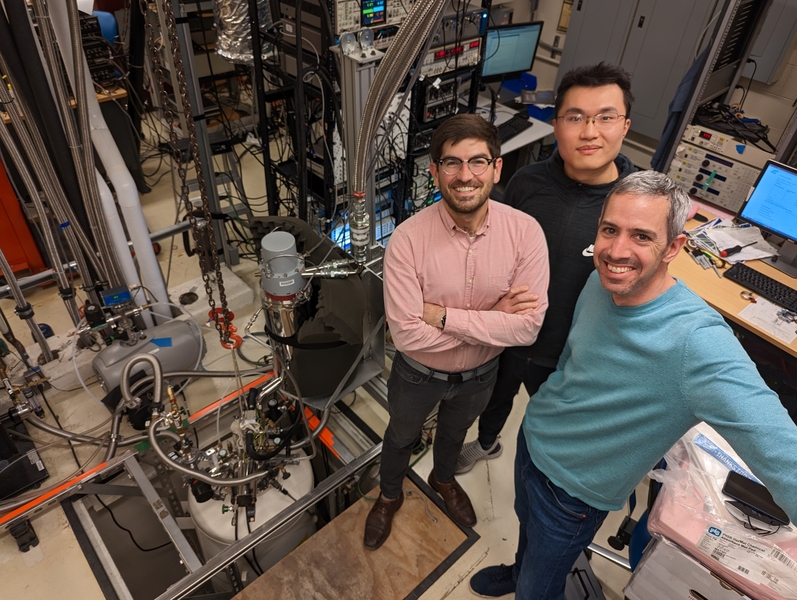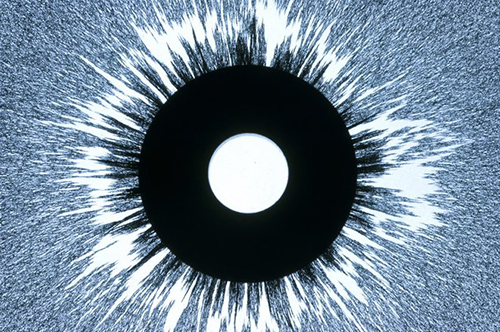

Magnetism is the class of physical attributes that occur through a magnetic field, which allows objects to attract or repel each other. Because both electric currents and magnetic moments of elementary particles give rise to a magnetic field, magnetism is one of two aspects of electromagnetism.
The most familiar effects occur in ferromagnetic materials, which are strongly attracted by magnetic fields and can be magnetized to become permanent magnets, producing magnetic fields themselves. Demagnetizing a magnet is also possible. Only a few substances are ferromagnetic; the most common ones are iron, cobalt, nickel, and their alloys.
All substances exhibit some type of magnetism. Magnetic materials are classified according to their bulk susceptibility.
Ferromagnetism is responsible for most of the effects of magnetism encountered in everyday life, but there are actually several types of magnetism. Paramagnetic substances, such as aluminum and oxygen, are weakly attracted to an applied magnetic field; diamagnetic substances, such as copper and carbon, are weakly repelled; while antiferromagnetic materials, such as chromium, have a more complex relationship with a magnetic field.
The force of a magnet on paramagnetic, diamagnetic, and antiferromagnetic materials is usually too weak to be felt and can be detected only by laboratory instruments, so in everyday life, these substances are often described as non-magnetic.
The strength of a magnetic field always decreases with distance from the magnetic source, though the exact mathematical relationship between strength and distance varies.
Many factors can influence the magnetic field of an object including the magnetic moment of the material, the physical shape of the object, both the magnitude and direction of any electric current present within the object, and the temperature of the object. Read more ...
The future of magnetics in transportation holds the promise of even faster, more efficient, and eco-friendly modes of travel. Magnetic levitation could be applied to urban transit, reducing traffic congestion and lowering carbon emissions. In the medical field, magnetics are making strides in diagnosis and treatment.
Gravity is not related to magnetism. Five key differences between gravitational and magnetic forces include: gravity is always attractive, while magnetism can be both attractive and repulsive; gravity acts on all objects with mass, while magnetism acts on charged particles in motion; gravity has an infinite range, while magnetic forces have a limited range; gravity's strength is weaker than magnetic forces; and gravity is always attractive, while magnetic forces can be either attractive or repulsive.
- P-wave magnetism: MIT physicists demonstrated a new form of magnetism called p-wave magnetism in nickel iodide (NiI2). This new magnetic state is a combination of ferromagnetism (like fridge magnets) and antiferromagnetism. This discovery has the potential to lead to the development of faster, denser, and more energy-efficient "spintronic" memory chips.
- Altermagnetism: Researchers have obtained the first conclusive evidence of a third class of magnetism called altermagnetism. This type of magnetism could revolutionize the design of high-speed magnetic memory devices and contribute to the development of better superconductors.
- Magnetism in an atomically thin material: Physicists discovered and explained unexpected magnetism in a material that is only one atom thick, providing a new platform for studying quantum materials.
- Superconductor also a magnet: Scientists found that a newly discovered type of superconductor also exhibits magnetic properties when cooled to a certain temperature. This could lead to further understanding of the relationship between superconductivity and magnetism. Improvements in opto-magnetic technology: Researchers created platinum-mixed metallic magnetic nanofilms that are significantly more efficient, potentially leading to more energy-saving solutions in various applications.
- Updates to the World Magnetic Model: The World Magnetic Model (WMM) 2025 has been released, providing more precise navigational data by improving the model of Earth's magnetic field and its temporal changes. This release includes a higher resolution version for greater directional accuracy.
These discoveries indicate an active field of research with exciting potential for future technological advancements, particularly in areas like data storage, energy efficiency, and fundamental quantum research.
New method decodes the hidden origins of magnetism PhysOrg - July 25, 2025

Magnetism originates from the quantum mechanical properties of electrons, specifically their intrinsic spin and orbital angular momentum. Within atoms, electrons occupy orbitals—regions of space defined by quantum numbers—such as s, p, d, and f orbitals, each with specific shapes and capacities. Magnetism arises primarily from unpaired electrons in the d and f orbitals, which are more spatially extended and allow for stronger interactions between atoms.
Physicists observe a new form of magnetism for the first time Live Science - June 7, 2025

MIT physicists have demonstrated a new form of magnetism that could one day be harnessed to build faster, denser, and less power-hungry "spintronic" memory chips. The new magnetic state is a mash-up of two main forms of magnetism: the ferromagnetism of everyday fridge magnets and compass needles, and antiferromagnetism, in which materials have magnetic properties at the microscale yet are not macroscopically magnetized. Now, the MIT team has demonstrated a new form of magnetism, termed "p-wave magnetism."
Physicists discover and explain unexpected magnetism in an atomically thin material. The work introduces a new platform for studying quantum materials. MIT - January 23, 2025

MIT physicists have created a new ultrathin, two-dimensional material with unusual magnetic properties that initially surprised the researchers before they went on to solve the complicated puzzle behind those properties’ emergence. As a result, the work introduces a new platform for studying how materials behave at the most fundamental level — the world of quantum physics.
Physicists Found a Brand-New Kind of Magnet Hiding in a Uranium Compound Live Science - February 9, 2019

Scientists have discovered a brand-new kind of magnet hiding out in a uranium compound. The compound, USb2 (a compound of uranium and antimony), a so-called "singlet-based" magnet, is novel in that it generates magnetism in an entirely different way than any other magnet known to scientists. Electrons, which are negatively charged particles, generate their own tiny magnetic fields. These fields have a "north" and "south" pole, a consequence of a quantum mechanical property known as spin. In most objects, these magnetic fields point in random directions, canceling each other out. (This is why your body isn't a giant magnet.) But in certain materials, those fields become aligned. When that happens, they create a magnetic field powerful enough to, for example, move a bunch of iron filing around or cause a compass to point north.